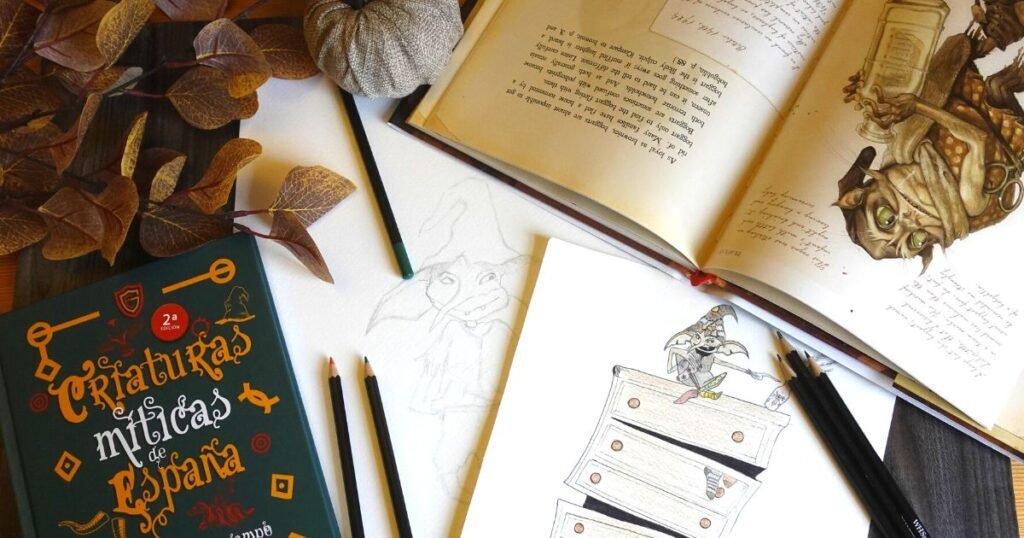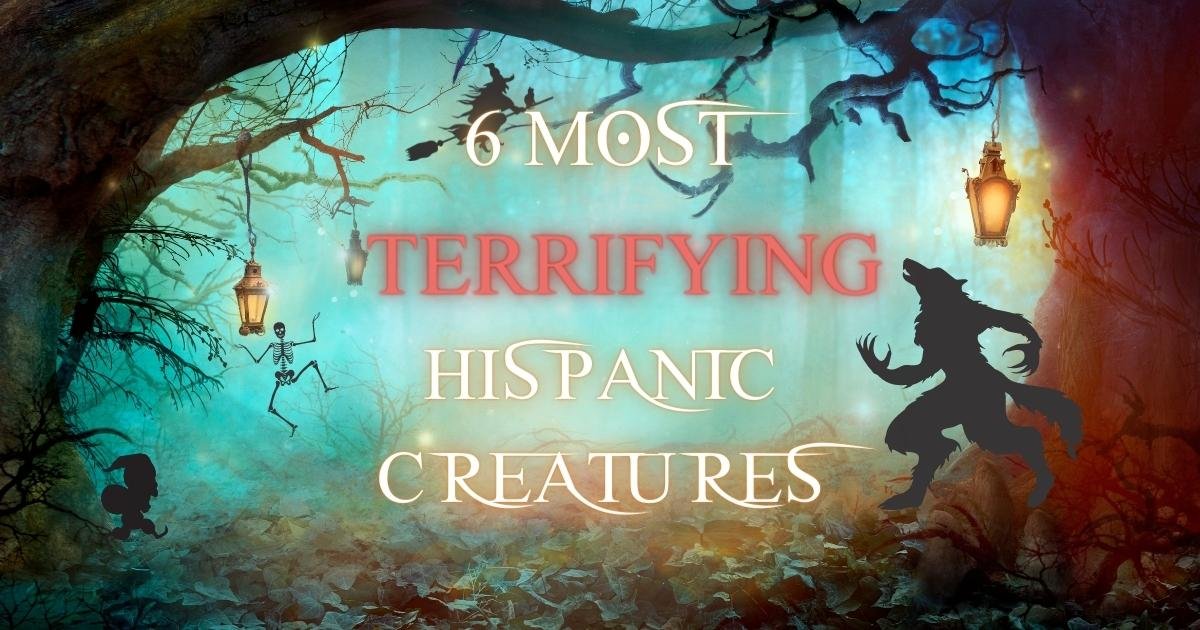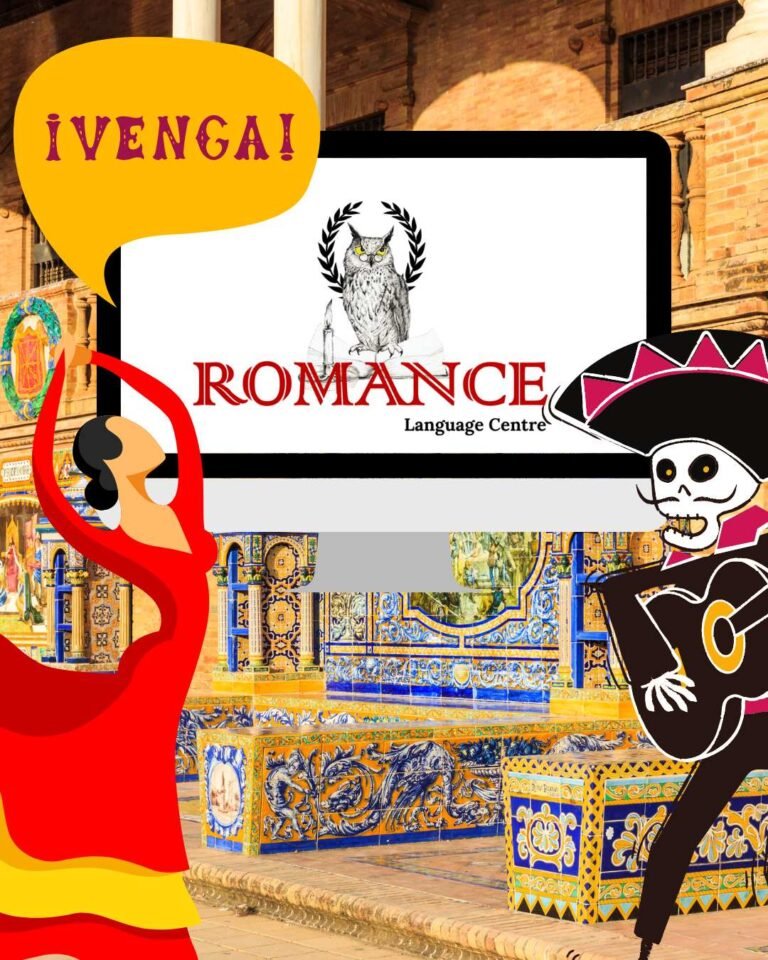Witches that cause illnesses and towns dedicated to them, processions of cursed souls that haunt the streets, mischievous goblins, black, horned dogs as omens of death… Not many regions of the world have mythology as rich as the Hispanic world. In this article we are bringing you a very narrow selection of some of the most famous myths and legends to be on the lookout for this Halloween.
Spain and Latin America have a rich, varied mythology due to their history and their people’s natural predisposition to everything that transcends the limits of everyday and ordinary. Just think of the literary phenomenon realismo mágico birthed in Latin America in the past century.
We have no doubt in our mind that you’ve heard of Mayas, Incas and Aztecas, and are probably somewhat familiar with the above- mentioned creatures. This could mostly be due to the closeness to the United States that popularized their existence through movie references and even movies in its own right, such as The Curse of La Llorona. But did you know that Spain, especially its northern part, has an even more imaginative, widely-spread mythology?
Celtic traces can be seen to this day in the north of Spain. From the mystical fortifications called castros to bagpipes being the national instrument, to the road signs warning of meigas – witches. And most importantly, the many myths and legends that have found a way to coexist with the everyday life of their people.
In this article, we’re going to mention just some of them to give you a little taste.
1. LAS MEIGAS
Imagine driving down a misty, winding road in the north of Spain and suddenly you see a street sign with a meiga on it. All we can say is: welcome to Galicia. To quote the famous and beloved sentence by Miguel de Cervantes: ‘Yo no creo en las brujas, pero de haberlas haylas.’

If you hear this often in Galicia, it is because it summarizes the complex character of its people perfectly. On one hand, los gallegos are practical and objective. On the other, they’re full of mystery and magic that imbues their very land, forests, rivers and lakes. They don’t believe in as meigas. But do they exist? They certainly do.
But what is the difference between meigas and brujas? Meiga is what is known as bruja, a witch, in the rest of Spain. She is the benevolent witch, who creates potions and ointments to help people and is devoted to good deeds. The term meiga is used in Galicia with cariño. It is as much the symbol of Galicia as are its dense forests and cliffs reminiscent of Ireland from where their ancestors came.
But has it always been like that? You don’t have to be a history buff to have heard of the Inquisition, which sowed terror in the whole of Spain. You might have heard of or seen the Spanish comedy Las brujas de Zugarramurdi, which we covered in our previous article.
Despite its overall tone, there is underlying seriousness and the village Zugarramurdi is one of the best known cases of witch hunt in Spain. Going back to the beginning of 17th century, a witch hunt started in the south of France. Out of fear that the witches had crossed the border and come to the Península, they started looking for witches in Spain as well. In Zugarramurdi, specifically, most of the population was accused of witchcraft and 39 women were burned alive.
Today, meiga has positive and patriotic connotations in Galicia. When something goes wrong for a gallego, or they find themselves in a situation that’s difficult to explain, they’ll shrug and say it’s ‘cosa de meigas.’
Even if you don’t find any witches in Galicia, you will find magic in the land itself. We recommend you read the rest of this article while listening to some Galician music, in the beautiful and romantic Galician language.
2. EL URCO
In almost every mythology of the world, there is mention of the large, black dog – the harbinger of bad fate. We could see that even in Harry Potter, when the Professor Trelawney dramatically announced: ‘My dear…you have the Grim.’
The north of Spain, which has always had a rich death imagery, is no exception. Both the names and the descriptions vary. El Urco is also known as can do mar, can do urco, perro negro, el huerco in Asturias and, sometimes, even as perro blanco.
Just like the Hellhound and other ominous or hellish supernatural dogs in mythologies around the world, El Urco is commonly associated with graveyards and the underworld.
What makes El Urco unique to Spain, however, is its connection to the maritime territory. It is believed that El Urco resides in misty el Borrón, part of el Más allá (The Great Beyond, The Underworld). This place situated beyond the sea and close to Hell. He emerges from the sea on the nights of full moon, his colossal body wrapped in heavy chains. It goes without saying that El Urco’s apparition is terrifying. He is believed to have horns, red or yellow phosphorescent eyes and extremely large ears. If you see him, best believe you’re dead.

It is very likely that El Urco’s name proceeds from the Roman god of death, known as Orco. He announced imminent death to humans and kept the souls of the deceased hidden. The Spanish version of the ominous black dog, however, isn’t always that solitary. Sometimes, the stray dogs from the area will follow El Urco in his wandering around the cemeteries and houses of people who will die soon.
There are many ways in which El Urco can announce death. By stopping in front of a house, by huffing or howling before the door or making the accompanying black dogs run three times around the house.
Once he’s finished with his nightly visit, he returns to the sea before the dawn while the stray dogs are left observing from the shore.
Such is the popularity of el Urco in Galicia that a carnival (Entroido) in his honor was introduced in 1877. For a visual, we recommend you see a Galician TV show, Néboa, that opens with the scene from Entroido – when the killer named el Urco takes his victims.
You can watch it for free HERE.

2. EL DUENDE
El duende is, without doubt, one of the most popular figures in Spanish mythology. The name is a contraction from the old Castillian duen de casa (dueño de casa, master of the house). Despite there existing many descriptions of duendes as forest creatures, the etymology itself indicates the close relation between El Duende and the house.
If the word sounds familiar to you, this is because el duende has two very different meanings in Spanish. Have you ever watched a performance, and felt moved to tears by an unexplainable, yet overwhelming emotion? This is what Spaniards mean when they say tiene duende.
We, however, are more interested in the mystical force that lurks in attics, nooks and crannies and wreaks havoc on households. This unwelcome visitor is by no means a recent addition to the rich tapestry that is Spanish mythology. Since antiquity it was believed that there is a creature residing in the house, committing small mischiefs, misplacing things, moving things around, opening and closing windows and doors and making all sorts of noises. As soon as someone approaches to see what is happening, they, of course, find nothing.

Just how rooted the belief in this small rascal is in Spanish culture can be seen in the numerous mentions in the works of classical authors. One of the greates Spanish playwriters, Calderón de la Barca , makes fun of his people’ superstitious beliefs in the play La dama duende.
Did you know that in the 16th century Spain claiming that your house was infested by El Duende was legitimate cause to break the tenancy agreement? El Duende in his play, however, isn’t the mysterious creature: it is the lady of the house who is mischievous. Whenever something’s out of place or goes missing, she blames it on El Duende, hence the title.
Following the Harry Potter analogy, think of El Duede as you would of Peeves, the notorious and troublesome poltergeist that haunts the halls of Hogwarts.
El Duende will make your washing machine break down, hide your keys, and, ever wonder how you can never find that other pair of socks?
Being so small and elusive, El Duende is able to crawl into most places and get out just as easy. When it comes to physical appearance, he’s most similar to goblins from other European folklores, with his large pointy ears and greenish skin. In Galicia, El Duende has a hole in hand and is better known as El Trasno.
In Aragón, this creature is known as El Martinico and it brings sleep to children, hence the expression Ya viene Martinico, indicating that children are sleepy.
So the next time you can’t find that other sock – maybe it was El Duende!

3. LA SANTA COMPAÑA
La Santa Compaña is, undoubtedly, one of the most widely-spread and deep-rooted myths of Spain. She is also known as la Güestia in Asturias, la Estantigua in parts of Castilla, or Corteju de Genti de Muerti in Extremadura. All of these names are alluding to the dead souls and hosts. The saint part, however, is the most dubious one. According to El Diccionario de los Seres Míticos Gallegos, la Santa Compaña is a lot of things, but saint isn’t one of them.
Most likely, this is a myth of pagan origin mixed with elements from European folklore that was lately falsely Christianised. If you’ve heard of the Wild Hunt, a myth of German origin widespread through the Europe, then you know the gist. The lost souls that wander the Earth together, a bad omen presaging some catastrophe or death of the one who witnessed it.

Despite its many names and variants, the most widely accepted depiction of la Santa Compaña is that of a procession of souls from Purgatory that rises at midnight to start their el recorrido. The procession is led by one alive person who is carrying a crucifix and a cauldron filled with holy water. That person is in a sort of trance and doesn’t remember anything the following day. Each soul carries a candle that, just like them, can’t be seen but the scent of wax is told to linger in the air as they pass.
The only way that a person leading the procession can break the curse is by passing the crucifix to the next person. There is one theory that suggests that the person leading is someone who’s been very sinful in life. Sometimes, weeks can go by without finding another person to whom to pass the burden. Without any recollection of the night before and feeling constantly tired and drained, the person withers away and eventually dies.
The Spanish word for what members of this eerie procession are is almas de pena – wights. The closest we can get to the pop culture depiction is through the barrow-wights from the Lord of the Rings.

La Santa Compaña, however, doesn’t just go around looking for the new leader of the procession. Just like el Urco, it is believed to be a death omen. The person who sees la Santa Compaña will die by the end of the year, according to the popular belief.
This is one of the most feared myths, especially in the northern part of Spain where the everyday life and the mystical and magical go hand in hand.
As la Santa Compaña is making its way through parroquia, the animals in the forest go quiet, the dogs in the village start barking madly, and the cats run away scared. You might not be able to see them, but you will feel a chill go down your spine and scent the melted wax on the wind.
But is there a way to protect oneself from la Santa Compaña? Allegedly, one way is to trace a circle on the ground and get inside. The other way is to lay face-down and wait for the procession to pass by.
Or, you know – run like hell.
If you’ve liked what you’ve learned so far and would like to hear about more creatures specific to Spain, we recommend you watch this amazing and very atmospheric documentary about Galician mythology.
And now we’re moving on to two very different looking but equally popular female figures from the Latin American mythology.
4. LA LLORONA
Latin America has always been rich with oral culture due to the indigenous groups that created their own cosmologies. And the legend about La Llorona, in its many variations and forms, has become a part of the collective unsconsicousness and cultural identity of Latin America.
La Llorona is also one of its most recognized figures internationally. She has been the protagonist of 16 (!) movies since 1933 till today, both in Latin American and foreign movies. But, who is La Llorona really and how did the legend come to be?

La Llorona is the ghost of a woman that wanders around different places, usually close to rivers, lakes, villages and towns, wailing inconsolably for the crime she had committed – the murder of her children. However, as it often happens with tales and legends, there isn’t a single version of the story. There can even be several different versions within the same country, depending on the geographical location. Usually, the story changes with the following elements:
- The origin of the woman. She is either criolla, mestiza or an indigenous woman
- The way in which she commits the crime, by drowning her children in water or using a knife
- Why she appears. She feels nostalgia for her children, or she appears to those who are unfaithful to their partners, or to drive mad the people who witness her apparition
- The reason for which she commits the crime. It can be the husband’s abandonment or infidelity, or betrayal of her raza
Elements that don’t change are the water, that is always present in one way or the other, as well as her white clothes and the veil that covers her face. She is perhaps best known for her bone-chilling scream (¡Ay, mis hijos!’) known as el grito de La Llorona.
For the fans of the CW TV show Supernatural, you probably remember the first episode ever, about Constance Welch, the woman in white who haunts the highway in search of unfaithful partners, driven mad by the drowning of her children.

However, the legend about La Llorona dates much further back, to the pre-Hispanic era and is often associated with the goddess Tenpecutli, a deity known for filicide, the drowning of her children in a river.
The arrival of conquistadors took the narrative in a different direction. One of the Mexican versions of the legend connects the spirit of La Llorona with La Malinche , the enslaved indigenous woman offered by cacique to the Spanish conquistador Hernán Cortés. She would become his translator and later wife. According to this version, the reason why La Llorona appears is the regret for abandoning her people. The infamous scream in this context is the lament of Latin American nations for the hardships endured during the Conquista.
There are as many versions as there are interpretations of this figure, but no matter which version you prefer – beware of women clad in white wandering the streets this Halloween.
5. LA CATRINA
The last but certainly not the least figure on our list is La Catrina – the beloved colorful skeleton woman whose popularity has long surpassed the borders of her natal Mexico. But who is she really and has she always been as cheerful?
Let’s take a short trip to the past. The year is 1910 and the caricaturist José Guadalupe Posada has just created a zinc etching of the so-called La Calavera Garbancera, which is Catrina’s original name. This, however, is a lot more than just an illustration. It’s a social criticism.
Las garbanceras were modest Mexican women who sold chickpeas on the market but acted as if they were something else. The character criticized them for negating their indigenous roots and dressing up as European women. This is why his La Garbancera is wearing an elegant hat, with ostrich feathers, as per Parisian fashion.

But, what do the skeletal appearance and death have to do with any of this? Through his depiction of las garbanceras, the character wanted to prove that none of it matters in the end. We all die and we all become dust and bones. Therefore, all those women in their fancy dresses are nothing but otra calavera del montón.
La Catrina, as we know her today, was birthed when the famous Mexican painter Diego Rivera included her in his mural Sueño de una tarde dominical en la Alameda central in 1947.

Nowadays, la Catrina is the source of inspiration for many masquerade parties and carnivals. It has become impossible to imagine El Día de Muertos party without women dressed as La Catrina, with sumptuous dresses, faces painted as skulls and flowers or hats with feathers.
For those who don’t know, El Día de Muertos is the national bank holiday in Mexico, celebrated on the 1st and 2nd of November. To chagrin of many traditional Mexicans, some of the aspects of Halloween have crept into their separate, and in essence, very different holiday. Not only that, but the figure of La Catrina has become so popular internationally that it has become adopted and appropriated according to the Halloween aesthetics.

You might’ve noticed, both in the case of La Llorona through the story of La Malinche, and La Garbancera/La Catrina, that Mexicans have a hard time with Europeanisation /Americanization of their traits, customs and traditions – especially when they’re the ones doing it. This dichotomy between despising everything that’s foreign and at the same time wishing to be just like that, is a phenomenon known as el malinchismo.
If you would like to study this topic in depth, we recommend the insuperable book of essays by Octavio Paz, El laberinto de la soledad. The fact that Octavio Paz himself is Mexican gives his honest insight into Mexican psyche even more weight.
For a lighter approach, we recommend you see Coco, an animated movie that has been praised by Mexicans themselves for its take on the significance and essence of El Día de Muertos.
If you like the sound of La Catrina and would like to learn Spanish through her story, we have an exciting announcement to make.
LISTEN, PRACTICE, WRITE AND LEARN WITH ROMANCE
At Romance Language Centre, we work hard to provide you with original and valuable resources that will boost your grammar, vocabulary and understanding of the culture and language.
For this Halloween, we bring you 60 pages and 15+ worth of didactic and audio content packed with engaging illustrations, visuals and most importantly – valuable lessons. All packed in an original whodunnit story ¿Quién mató a la Catrina? that you can download for FREE for a limited time.
This original historia de misterio is aimed at A2 level learners and will test and enhance your knowledge through a mystery: who killed la Catrina? You will find clues, interrogate witnesses, formulate theories, learn Halloween and Day of the Dead vocabulary, and immerse yourself in an entire investigation conducted by la Inspectora Gatita.
We’ve also prepared for you a separate resource that explores the history of La Catrina and El Día de Muertos through texts, audios and activities.
Check out the video that accompanies one of the resources and learn more about how to celebrate Día de los Muertos.















